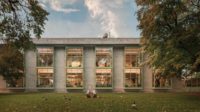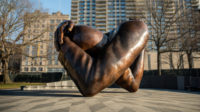MIT Unveils Memorial for Officer Killed by Boston Bombers

During the sentencing phase of convicted Boston Marathon bomber Dzhokhar Tsarnaev’s trial in April, an extraordinary memorial was unveiled at MIT. Dedicated to the campus police officer killed by the Tsarnaev brothers as they fled, the Sean Collier Memorial is both a poetic sculptural form and an amazing feat of engineering and technology. The structure was designed by the Boston architecture firm Höweler + Yoon (H + Y) as a five-way vault of solid masonry: five asymmetrical arms or buttresses that support a shallow central arch to create a space for visitors to pause and reflect. The Collier memorial sits on the spot where the officer was shot, just in front of the MIT Stata Center designed by Frank Gehry. In counterpoint, it creates a powerfully solid yet sinuous presence.
 |
|
Photo © Peter Vanderwarker
|
Made of 32 blocks of gray granite from a quarry in Virginia, the memorial was digitally designed and fabricated as a self-supporting structural system. Meejin Yoon, a founding principal of the firm and head of the department of architecture at MIT, worked on the design with her academic colleague John Ochsendorf, an engineer well-known for his research and work with masonry vaults, as well as with the Institute’s architecture and engineering students. The Virginia Mist granite was cut by robot in Wisconsin—each piece milled within a .5-millimeter tolerance—and assembled on-site. Sean Collier’s brother Rob Rogers was the construction manager. The words he spoke at Collier’s memorial service are carved into the piece: “Live long like he would. Big hearts, big smiles, big service, all love.”
The dry-masonry technique of such a complex form is a tour de force that combines “the most ancient stone technology with the most contemporary tools,” said H + Y principal Eric Höweler. Its design also seems to exemplify the MIT motto Mens et manus or “Mind and hand.” With the underside of its vaults polished and external surfaces rough, subtly emphasizing the improbably thin elegance of the monument’s arms and central arch, this stunning structure is both grounded and flowing, somber and joyful—a tribute not only to the man who lost his life but to the minds, hands, and hearts of those who created it.






